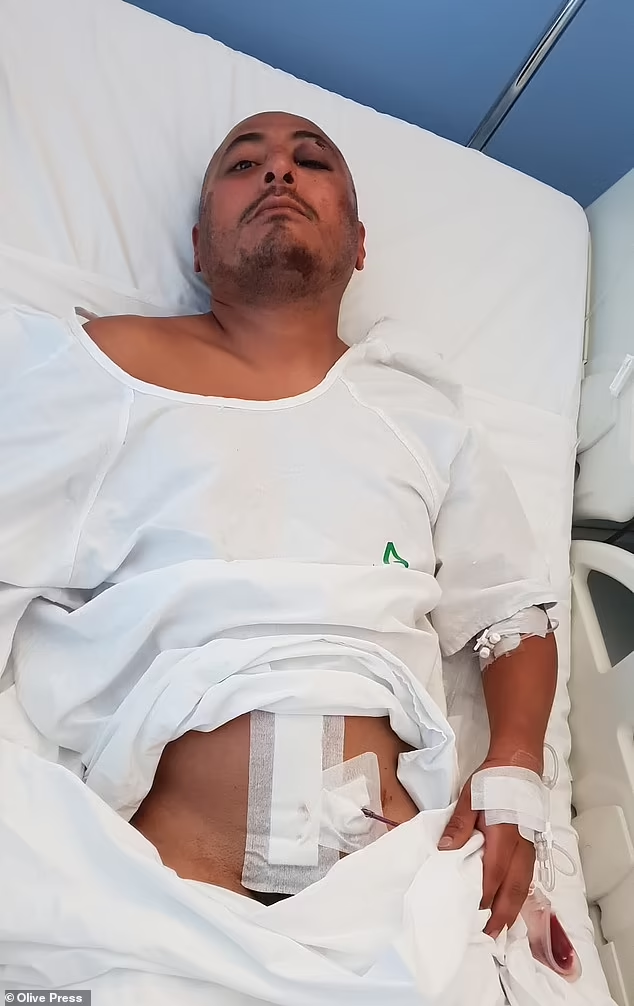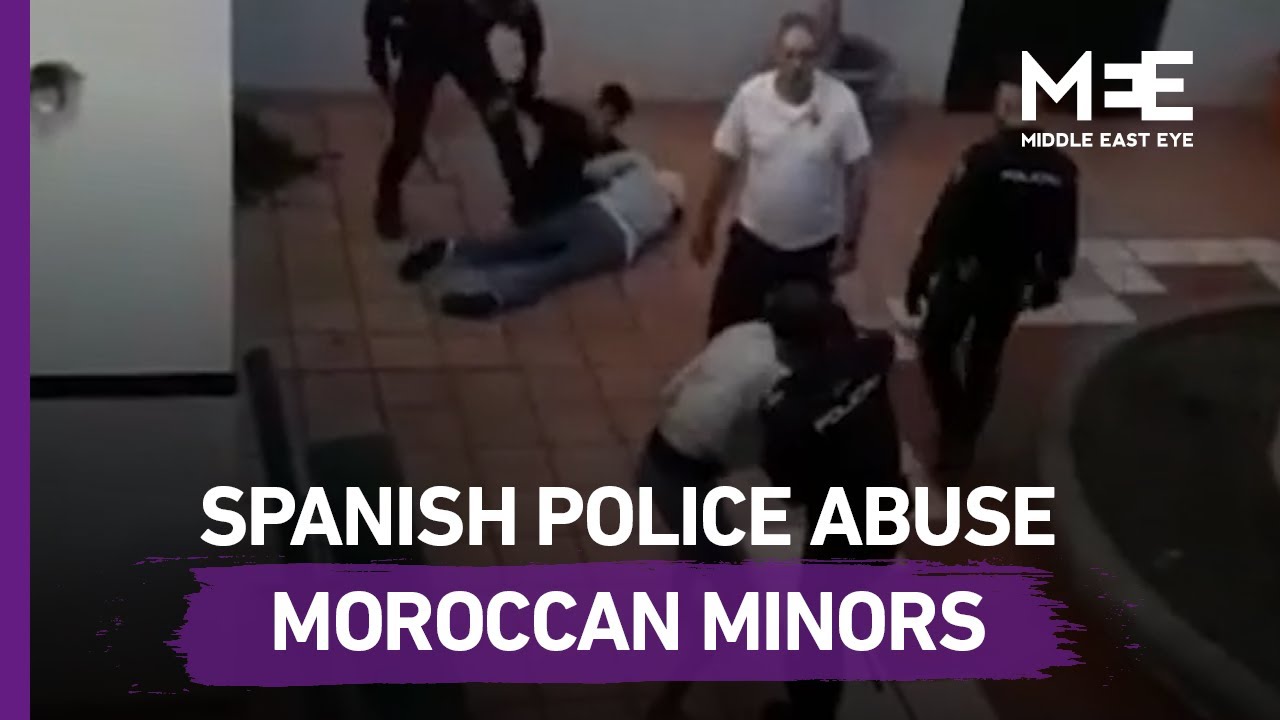Endemic Racism in SPAIN... The Country which Glorifies Racial Hatred.
Please watch all of the Videos below, so you can see that the alegation of Endemic Racial Hatred in Spain is real.
SPAIN... The only country in the world which includes in schoolroom curriculum, the methodology of denial of racism. (Why would children need to be trained to deny racism)
General scheme for the family reunification visa....
Visa for family members of foreigners who already have legal resident status in Spain and who wish to exercise the right to family reunification. This type of visa is not issued to family members of citizens of the European Union or of the Member States of the European Economic Area or of Switzerland (see “Visas for family members of EU citizens").
Family members who can obtain a family reunification visa
- The spouse, not separated in fact or in law, or the person who maintains a partnership with the applicant that is analogous to a marital relationship (partner entered on a public register, provided that the registration has not been cancelled, or unregistered partner provided that proof can be provided of the continuity of a cohabitation relationship established before the applicant settled in Spain). Reunification cannot be offered to more than one spouse or partner.
- The children of the applicant, the children of the spouse or partner—including adopted children (provided that the adoption is valid in Spain)—and those represented legally by the applicant, provided that they are under the age of 18 or that they have disabilities and are not objectively capable of providing for their own needs due to their health status.
- The applicant's parents (mother or father) and those of their spouse or partner, provided that they are in the care of the applicant, they are older than 65 and there are reasons substantiating the need to authorize their residence in Spain. On an exceptional basis, and for humanitarian reasons, the reunification of parents under the age of 65 may be permitted.
Required documents
1. National visa application form. Each applicant must complete and sign a visa application form, filling in each of its sections. If the applicant is a minor, one of their parents or guardians or a duly accredited representative must sign the application. 2. Photograph. A recent, passport-size, colour photograph, taken against a light background, facing forward, without dark or reflective glasses, or any garments concealing the oval of the face. 3. Valid, unexpired passport. Original and a photocopy of the page or pages of the passport that contain biometric data. The passport must have a minimum validity period of 4 months and contain two blank pages. Passports issued more than 10 years ago will not be accepted. 4. Initial family reunification permit. Original and a copy of the initial family reunification permit issued by the Delegation or Sub-delegation of the Government in Spain, at the applicant's request. 5. Applicant's residence card. Certified photocopy of the applicant's Foreigner Identification Card, which must be unexpired. 6. Documents proving family relationship with the applicant.
- Spouses: Marriage certificate issued by the competent civil registry. In the event of second or successive marriage, proof of divorce from the previous spouse. Original and photocopy.
- Unmarried couples: Certificate of registration as an unmarried couple or, if the couple have not entered their relationship on a register, documents proving the couple's relationship dates back to before the applicant established their residence in Spain. Original and photocopy.
- Children: Birth certificate issued by the competent civil registry. In the case of the children of just one of the spouses or members of the couple, proof must also be provided that they hold sole parental authority over the child or that they have been awarded custody and that the child is effectively in their care. Original and photocopy.
- Parents: Birth certificate of the applicant or of the spouse or partner issued by the competent civil registry and documents substantiating the reasons for which it was necessary to authorize their residence in Spain. Among other documents, proof must be provided that, over the past year, the applicant has transferred funds to or covered expenses incurred by the parent representing, at least, 51% of the per capita GDP of the parent's country of residence. Moreover, proof must be submitted of the annual income and properties owned by the parent and information on other direct family members who are resident in the country. Original and photocopy.
Foreign documents must be legalized or apostilled and, where applicable, must be submitted together with an official translation into Spanish. 7. Criminal record check certificate. Applicants of legal age must submit both the original and a copy of the criminal record check certificate(s) issued by their country or countries of residence for the past 5 years. Foreign documents must be legalized or apostilled and, where applicable, must be submitted together with an official translation into Spanish. This certificate cannot be older than 6 months, unless the certificate itself specifies a longer expiration.For UK Criminal Records submit ACRO Certificate.These certificates must be legalised through the Spanish Representations in the issuing country or, in the case of signatory countries to the Hague Convention of October 5, 1961, hold the Hague Apostille, except official documents issued by a Member State of the European Union, which will not require to be legalised.Sworn translation into Spanish is also required.8. Medical certificate. Original and a copy of a medical certificate accrediting that the applicant does not suffer from any disease that could cause serious repercussions for public health pursuant to the 2005 International Health Regulations. Foreign documents must be legalized or apostilled and, where applicable, must be submitted together with an official translation into Spanish. This certificate must be issued by a registered medical practitioner no later than 3 months prior to the date of application, it must be formulated in the following terms or similarly:• If the medical certificate is issued in the United Kingdom: “This health certificate states that Mr./Mrs. (…) does not suffer from any of the diseases that may have serious public health repercussions in accordance with what is stipulated by the International Health Regulations of 2005”Certificates issued in a language different from Spanish must be accompanied by a sworn translation into Spanish.• If the medical certificate is issued in Spain: “Este certificado médico acredita que el Sr./Sra. (…) no padece ninguna de las enfermedades que pueden tener repercusiones para la salud pública graves, de conformidad con lo dispuesto en el reglamento sanitario internacional de 2005”This Consulate does not provide information about medical centres that issue this certificate. The applicant may contact any public or private medical centre duly accredited in the territory of the United Kingdom or Spain. Medical certificates issued in countries other than the United Kingdom or Spain will not be accepted.These certificates must hold the Hague Apostille (except documents issued by Spain, which will not require to be legalised).9. Proof of residence in the consular district.The applicant must provide proof of their legal residence in the consular district or that they are attending classes, in person, in the consular district. To verify your consular district, please visit the relevant web section of this Consulate.10. Proof of the representative's identity and capacity. If the applicant is a minor, a copy of the identity document or passport of the parent, guardian or representative and of the document constituting proof of kinship or guardianship or power of attorney or the document accrediting representation must be submitted. Original documents must be shown when submitting the application. Foreign documents must be legalized or apostilled and, where applicable, must be submitted together with an official translation into Spanish. 11. Payment of the visa fee. Visa fee payment is compulsory and has to be made at the same time when submitting a visa application. The fee has to be paid in local currency and it is subject to regular changes due to the currency fluctuations. Please check the list of Consular fees.When necessary to assess the application, the Consular Office may request additional documents or data and may also ask the applicant to come in for a personal interview.
Procedure
This Consular Office is competent to accept visa applications from individuals residing in the consular district
- Who can apply for a visa: The visa application must be submitted in person by the applicant. If the applicant is a minor, the application may be submitted by one of the parents or guardians or by a duly accredited representative.
- Visa application period: The visa application must be submitted within a period of 2 months, counted as of the day after the date on which the applicant is notified of the decision to authorize the family reunification.
- Place of submission: BLS. Spain Visa Application CentreSpain Visa Application Centre20 St Andrew Street, London EC4A 3AG
- Proof of receipt: The Consular Office will provide the applicant with proof of receipt of the application with a code that enables them to check the status of the dossier through the following link: https://sutramiteconsular.maec.es/Home.aspx
- Rectifying the application: The Consular Office may ask the applicant to submit any missing documents, or to provide additional documents or data that are necessary for a decision regarding the application. The applicant may also be called in for a personal interview.
- Decision period: The legal period for reaching a decision is of 2 months as of the day after the application submission date, but this period may be extended if an interview or additional documents are requested.
- Collecting the visa: The visa must be collected in person by the applicant or by their representative (if the applicant is a minor) within a maximum period of 1 month, counted as of the day after the date on which the favourable decision is notified. The Consular Office will inform the applicant regarding the procedure for the return of the passport and any other original documentation.
- Visa refusal: Visa refusals will always be notified in writing, setting forth the grounds on which the decision adopted was based.
- Appeals: If a visa is refused, the applicant may submit an appeal for reconsideration to this Consular Office within 1 month of the day following the date on which notification of the refusal is received.The appeal addressed to the Visa Department must be posted by Royal Mail or other courrier service provider to this Consulate.An application for judicial review may also be filed with the High Court of Justice of Madrid within the 2-month period beginning the day after the date on which the applicant receives notification of the visa refusal or of the dismissal of the reconsideration appeal.
- Validity period of the visa: The visa will be valid for 90 days. Once in Spain, a Foreigner Identification Card must be applied for within a period of 1 month from the applicant's entry into Spain, at the Foreign Nationals' Office or the Police Station of the province in which the residence permit was processed.
SWORN TRANSLATIONS AND LEGALISATIONSPlease visit the relevant web section of this Consulate for the list of sworn translators-interpreters.The legalisations and Hague Apostilles must legalise the signatures of the signatories of the certificates: registered medical practitioners, police officers, etc. and not the signature of notaries or solicitors who did not issue those certificates.The Hague Apostille does not need to be translated into Spanish if one of the languages of issuance is Spanish.
Please protest against Spanish CRIMES AGAINST HUMANITY BASED ON RACISM...
A History of Racism Spain...
Racism in Spain can be traced back to any historical era, during which social, economic and political conflicts have efficiently been justified by racial differences, be it in the form of racism as an ideology or in the form of racism as simple attitudes or behaviors towards those who are perceived as being different. More common than racism per se are the attitudes linked to xenophobia and nationalism (specially the Spanish, the Catalan and the Basque ones), as well as religious and/or linguistic-cultural hatred.
 A resident (pictured in hospital) living near Marbella on the Costa del Sol is sounding the alarm after claiming he was beaten so savagely by cops that he was hospitalised with a punctured bladder
A resident (pictured in hospital) living near Marbella on the Costa del Sol is sounding the alarm after claiming he was beaten so savagely by cops that he was hospitalised with a punctured bladder
During the Spanish inquisition, the descendants of Jews and Muslims were targeted the most. This policy was called Limpieza de sangre (Blood Cleansing). Even after a Jew or a Muslim (Muwallad, an Arab or a Berber) converted to Christianity, the contemporary Spanish authorities referred to them and their descendants as New Christians, and as a result, they were the targets of popular and institutional discrimination and they were also the targets of suspicion by the Spanish Inquisition.[1] New Christians of Muslim heritage were referred to as moriscos, meaning Moor-like.[2] Those of Jewish heritage were termed Conversos and those who secretly continued to practice Judaism were referred to as marranos (either from the Spanish word marrar which means to err/deviate or from the Spanish word marrano which means "swine".).[3] After the Reconquista, many Mudéjars (individual Moors, who remained in Iberia after the Christian Reconquista but were not converted to Christianity) remained in Spain as practicing Muslims and Sephardic Jews were required to convert to Catholicism or leave the country in 1492. Attitudes towards Moriscos varied in different regions, but they were never the main targets of the Inquisition. A few decades after the War of the Alpujarras, during which the Muslim-majority population of Granada rebelled, the King of Spain ordered the Expulsion of the Moriscos from Spain, which was successfully implemented in the eastern region of Valencia and was less successfully implemented in the rest of Spain. While Medieval persecutions of Jews and Muslims were aimed at converting or eliminating non-Christians, limpieza de sangre was linked to the ancestry of the new Christians, regardless of their fervor or their lack of it.
Enslavement of Sub-Saharan Africans[edit]
During the Late Middle Ages and during the Modern era, a small number of Sub-Saharan Africans were captured or bought and sold as slaves.[4] The slaves who were born in Sub-Saharan Africa were called bozales. Their descendants were called Black Ladinos because they had a better command of the Spanish language. During the Spanish colonization of the Americas, the territories which were inhabited by Native Americans were massively depopulated as a result of mass genocide, Old World illnesses and the hardships which were caused by the conquest and the exploitation which followed it. Sub-Saharan African slaves were taken to the Indies as laborers. Initially, they were taken from Spain and later, they were taken from Sub-Saharan Africa. Today, the descendants of these enslaved black people still populate the former Spanish colonies and as a result, they constitute a major community within the African diaspora. [5]
The Gitanos are the descendants of Romani people who migrated from Northern Africa and France and arrived in Spain in the late Middle Ages. They lived a nomadic lifestyle until the 20th century and as a result, they were blamed for crime by the sedentary population. The authorities' treatment of the Gitanos varied from persecution to forcible assimilation.The Gitanos are the descendants of Romani people who migrated from the Indian Subcontinent and began migrating towards Europe during the 10th and 11th centuries. The earliest documentation of Romani people’s presence in Spain is traced back to the 15th century.The Roma population is the longest-standing ethnic minority in Spain and has a long history of being discriminated against and ostracized in both Spanish and European history. Discrimination based on ethnocultural differences and physical characteristics (such as skin color) has contributed to the exclusion of Roma populations and the historical persecution of the Roma in Spain. The Roma population is the most overlooked minority group in the formation of diversity policy in Spain. Demographic surveys taken from the years 2000 to 2007 found that 8% of the Spanish population was made up of Romani people. Many have assimilated into Spanish society, while others have continued to lead their traditional lives in small, isolated communities.Discrimination against the Roma community in Spain has not ended, and the United Nations special rapporteur on extreme poverty and human rights has spoken out about the mistreatment of the Roma/Gypsy community in Spain. In 2020 the UN reported that half of the 750,000 Roma living in Spain live below the poverty line and face contemporary forms of discrimination, such as job and housing discrimination. Socially, the Roma populations are less educated than the native Spanish population, and 70% of Roma adults in Spain are illiterate (European Roma and Travellers Forum).
Spread of scientific racism
From Wikipedia, the free encyclopediaRacism in Spain can be traced back to any historical era, during which social, economic and political conflicts have efficiently been justified by racial differences, be it in the form of racism as an ideology or in the form of racism as simple attitudes or behaviors towards those who are perceived as being different. More common than racism per se are the attitudes linked to xenophobia and nationalism (specially the Spanish, the Catalan and the Basque ones), as well as religious and/or linguistic-cultural hatred.
Historical roots[edit]
During the Spanish inquisition, the descendants of Jews and Muslims were targeted the most. This policy was called Limpieza de sangre (Blood Cleansing). Even after a Jew or a Muslim (Muwallad, an Arab or a Berber) converted to Christianity, the contemporary Spanish authorities referred to them and their descendants as New Christians, and as a result, they were the targets of popular and institutional discrimination and they were also the targets of suspicion by the Spanish Inquisition.[1] New Christians of Muslim heritage were referred to as moriscos, meaning Moor-like.[2] Those of Jewish heritage were termed Conversos and those who secretly continued to practice Judaism were referred to as marranos (either from the Spanish word marrar which means to err/deviate or from the Spanish word marrano which means "swine".).[3] After the Reconquista, many Mudéjars (individual Moors, who remained in Iberia after the Christian Reconquista but were not converted to Christianity) remained in Spain as practicing Muslims and Sephardic Jews were required to convert to Catholicism or leave the country in 1492. Attitudes towards Moriscos varied in different regions, but they were never the main targets of the Inquisition. A few decades after the War of the Alpujarras, during which the Muslim-majority population of Granada rebelled, the King of Spain ordered the Expulsion of the Moriscos from Spain, which was successfully implemented in the eastern region of Valencia and was less successfully implemented in the rest of Spain. While Medieval persecutions of Jews and Muslims were aimed at converting or eliminating non-Christians, limpieza de sangre was linked to the ancestry of the new Christians, regardless of their fervor or their lack of it.
Enslavement of Sub-Saharan Africans[edit]
During the Late Middle Ages and during the Modern era, a small number of Sub-Saharan Africans were captured or bought and sold as slaves.[4] The slaves who were born in Sub-Saharan Africa were called bozales. Their descendants were called Black Ladinos because they had a better command of the Spanish language. During the Spanish colonization of the Americas, the territories which were inhabited by Native Americans were massively depopulated as a result of mass genocide, Old World illnesses and the hardships which were caused by the conquest and the exploitation which followed it. Sub-Saharan African slaves were taken to the Indies as laborers. Initially, they were taken from Spain and later, they were taken from Sub-Saharan Africa. Today, the descendants of these enslaved black people still populate the former Spanish colonies and as a result, they constitute a major community within the African diaspora. [5]
Gitanos[edit]
| This section does not cite any sources. Please help improve this section by adding citations to reliable sources. Unsourced material may be challenged and removed. (December 2022) (Learn how and when to remove this template message) |
The Gitanos are the descendants of Romani people who migrated from Northern Africa and France and arrived in Spain in the late Middle Ages. They lived a nomadic lifestyle until the 20th century and as a result, they were blamed for crime by the sedentary population. The authorities' treatment of the Gitanos varied from persecution to forcible assimilation.The Gitanos are the descendants of Romani people who migrated from the Indian Subcontinent and began migrating towards Europe during the 10th and 11th centuries. The earliest documentation of Romani people’s presence in Spain is traced back to the 15th century.The Roma population is the longest-standing ethnic minority in Spain and has a long history of being discriminated against and ostracized in both Spanish and European history. Discrimination based on ethnocultural differences and physical characteristics (such as skin color) has contributed to the exclusion of Roma populations and the historical persecution of the Roma in Spain. The Roma population is the most overlooked minority group in the formation of diversity policy in Spain. Demographic surveys taken from the years 2000 to 2007 found that 8% of the Spanish population was made up of Romani people. Many have assimilated into Spanish society, while others have continued to lead their traditional lives in small, isolated communities.Discrimination against the Roma community in Spain has not ended, and the United Nations special rapporteur on extreme poverty and human rights has spoken out about the mistreatment of the Roma/Gypsy community in Spain. In 2020 the UN reported that half of the 750,000 Roma living in Spain live below the poverty line and face contemporary forms of discrimination, such as job and housing discrimination. Socially, the Roma populations are less educated than the native Spanish population, and 70% of Roma adults in Spain are illiterate (European Roma and Travellers Forum).
Spread of scientific racism[edit]
According to Gonzalo Álvarez Chillida, scientific racism, which was prevalent in Europe during the 19th and 20th centuries, can be considered a doctrine which "affirmed the inherited biological determinism of the moral and intellectual capacities of an individual, and the division of groups of humans into races differentiated by physical traits associated to immutable, inherited moral and intellectual traits" and "affirms the superiority of certain races over others, protected by racial purity and ruined through racial mixing", which "leads to the national right of superior races to impose themselves over the inferior". According to Chillida, such an ideology had difficulties in penetrating Spain due to the concept of "casticismo" which was inverted or ingrained in Spanish society, according to this concept, Spanish castes were considered religious lineages rather than races, in contraposition to the "Moor" and the "Jew". In the Spanish psyche, the Christian-Jewish dichotomy remained predominant over the more modern and racialized aryan-Semite dichotomy, which was developed in Northern Europe.[6]Eugenic ideas were slow to enter the country; the First Spanish Eugenics Conferences were held in 1928, and the second Spanish Eugenics conferences were held in 1933. Recasens Siches defended racist stances in those conferences.[7] Jurist Quintiliano Saldaña advocated the imposition of a national policy of sterilizations but he received a paltry amount of support in the country.[7]
Xenophobia among ethnic Spaniards
Along with the traditional racism against Jews, Muslims and Romani, Spaniards are known to have extremely xenophobic attitudes among themselves, depending on their region of origin and/or their mother tongue. Over the last 200 years, many Spaniards have nurtured a ferocious hatred for each other, depending on their mother tongue/nationalist identity (Catalan/Valencian, Galician and Basque speakers versus Spanish speakers; Catalan, Valencian, Galician and Basque nationalists versus Spanish nationalists). Nationalist antagonisms among Spaniards reached a climax during the Spanish Civil War and they paralleled the right-wing versus left-wing antagonism. The mass emigration of the Spanish-speaking population from the poorer regions of Spain to Catalonia and the Basque country exacerbated those antagonisms, because many Catalans, Valencians and Basques despised the newcomers because they were poor, a feeling which was exhacerbated by their fear that the Spanish central authorities were attempting to dilute ethnic Catalans, Valencians, Basques and northern Navarrese into the ethnic Spanish majority by using the newcomers as their tools. Nowadays, Spanish media outlets, particularly Spanish right-wing media outlets which are based in Madrid (specially journals like ABC, La Razón, El Mundo, El Español, OKdiario, Periodista Digital, Vozpópuli, Libertad Digital or even El País; as well as radio stations like esRadio or Onda Cero; and television channels like Intereconomía or Telemadrid), and Catalan (specially the main regional public television channel TV3, radio stations like Catalunya Radio, and journals like Avui or El Nacional.cat) and Basque nationalist (particularly the main regional public television channel Euskal Irrati Telebista) media outlets which are based in their respective regions, regularly tend to foment confrontations between Spaniards who are from different regions of Spain; these confrontations ultimately coincide with the conflicts of interest which exist between the Spanish central oligarchies which are based in Madrid, and the peripheral Catalan and Basque oligarchies which are based in Barcelona and Bilbao respectively. Most notably and particularly over the last decade, these conflicts have been exacerbated on account of the Catalan independence movement.
Don't let Spain get away with their Racial Hatred any longer....








